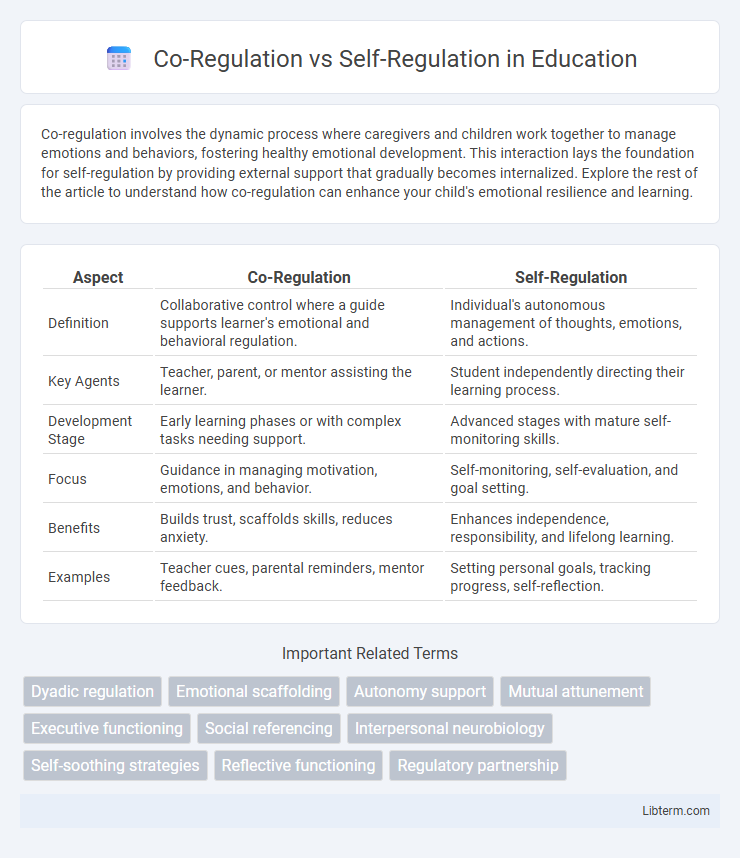Co-regulation involves the dynamic process where caregivers and children work together to manage emotions and behaviors, fostering healthy emotional development. This interaction lays the foundation for self-regulation by providing external support that gradually becomes internalized. Explore the rest of the article to understand how co-regulation can enhance your child's emotional resilience and learning.
Table of Comparison
| Aspect | Co-Regulation | Self-Regulation |
|---|---|---|
| Definition | Collaborative control where a guide supports learner's emotional and behavioral regulation. | Individual's autonomous management of thoughts, emotions, and actions. |
| Key Agents | Teacher, parent, or mentor assisting the learner. | Student independently directing their learning process. |
| Development Stage | Early learning phases or with complex tasks needing support. | Advanced stages with mature self-monitoring skills. |
| Focus | Guidance in managing motivation, emotions, and behavior. | Self-monitoring, self-evaluation, and goal setting. |
| Benefits | Builds trust, scaffolds skills, reduces anxiety. | Enhances independence, responsibility, and lifelong learning. |
| Examples | Teacher cues, parental reminders, mentor feedback. | Setting personal goals, tracking progress, self-reflection. |
Understanding Co-Regulation: Definition and Principles
Co-regulation involves a dynamic process where caregivers or supportive adults help individuals, especially children, manage emotions and behavior by providing external guidance and responsive interaction that gradually fosters independence. This approach is grounded in principles of attuned communication, emotional scaffolding, and mutual regulation, creating a foundation for developing self-regulation skills. Effective co-regulation supports neurological development and emotional well-being, balancing support with autonomy to enhance long-term self-regulation outcomes.
What is Self-Regulation? Key Components and Concepts
Self-regulation refers to the ability of an individual to manage their thoughts, emotions, and behaviors to achieve long-term goals, emphasizing personal control and adaptive responses. Key components include emotional regulation, impulse control, sustained attention, and goal-directed behavior, supported by metacognition and executive function skills. Concepts such as delayed gratification, stress management, and cognitive flexibility are central to effective self-regulation across various developmental stages.
The Science Behind Emotional Regulation
The science behind emotional regulation distinguishes co-regulation as an interactive process where individuals rely on external support to manage emotions, often involving caregivers or therapists who help modulate responses through empathetic connection. Self-regulation, by contrast, involves internal mechanisms such as cognitive reappraisal and physiological control, enabling individuals to independently modulate emotional intensity and recovery. Neurobiological studies highlight the role of the prefrontal cortex in self-regulation and emphasize the importance of secure attachment in early co-regulation for developing effective emotional control systems.
Co-Regulation vs Self-Regulation: Core Differences
Co-regulation involves external support where caregivers or educators guide emotional and behavioral control, whereas self-regulation is an individual's independent ability to manage emotions and impulses. Core differences emphasize that co-regulation serves as a developmental precursor to self-regulation, providing a structured environment for learning self-control skills. Research in developmental psychology highlights that successful self-regulation often depends on effective co-regulation during early childhood.
Benefits of Co-Regulation in Child Development
Co-regulation provides essential emotional support, helping children learn to manage stress and develop self-control through guided interactions with caregivers. It fosters secure attachment, enhancing social and emotional development by promoting trust and safety. This collaborative process also accelerates the development of executive function skills, laying a strong foundation for independent self-regulation.
Advantages of Self-Regulation Across the Lifespan
Self-regulation promotes autonomy by enabling individuals to manage emotions, behaviors, and impulses effectively from childhood through adulthood, fostering resilience and adaptive coping skills. Enhanced self-regulation supports academic achievement, mental health stability, and positive social relationships across the lifespan. Developing self-regulation early reduces dependence on external controls, facilitating lifelong personal growth and improved decision-making abilities.
The Role of Caregivers and Educators in Co-Regulation
Caregivers and educators play a critical role in co-regulation by providing emotional support and modeling self-control techniques that help children manage their feelings and behaviors effectively. Through consistent guidance, they create safe environments that foster trust and enable children to develop internal self-regulation over time. This interactive process enhances social-emotional skills and promotes resilience during early developmental stages.
Common Challenges in Developing Self-Regulation Skills
Developing self-regulation skills often faces challenges such as inconsistent emotional responses, difficulty managing impulses, and limited awareness of internal states that affect behavior control. In comparison to co-regulation, where external guidance provides support and scaffolding, self-regulation requires sustained practice in recognizing triggers and implementing coping strategies independently. These challenges can impact academic performance, social interactions, and overall emotional well-being, highlighting the need for targeted interventions and environmental support to facilitate skill acquisition.
Practical Strategies for Enhancing Emotional Regulation
Practical strategies for enhancing emotional regulation involve recognizing the interplay between co-regulation and self-regulation, where co-regulation provides external support through responsive caregiving or social interactions, helping individuals manage emotions before developing internal control. Techniques such as mindful breathing, labeling emotions, and structured routines support self-regulation by empowering individuals to regulate their own emotional responses effectively. Implementing consistent co-regulatory practices in early development fosters neural pathways that strengthen self-regulation skills essential for emotional resilience.
Choosing the Right Approach: Co-Regulation or Self-Regulation?
Choosing between co-regulation and self-regulation depends on the individual's developmental stage and contextual needs. Co-regulation involves external guidance and support, often essential for children or individuals learning emotional control, while self-regulation requires internal monitoring and independent management of behaviors and emotions. Assessing factors such as cognitive maturity, environmental stability, and specific goals helps determine the most effective approach for fostering emotional and behavioral regulation.
Co-Regulation Infographic

 libterm.com
libterm.com